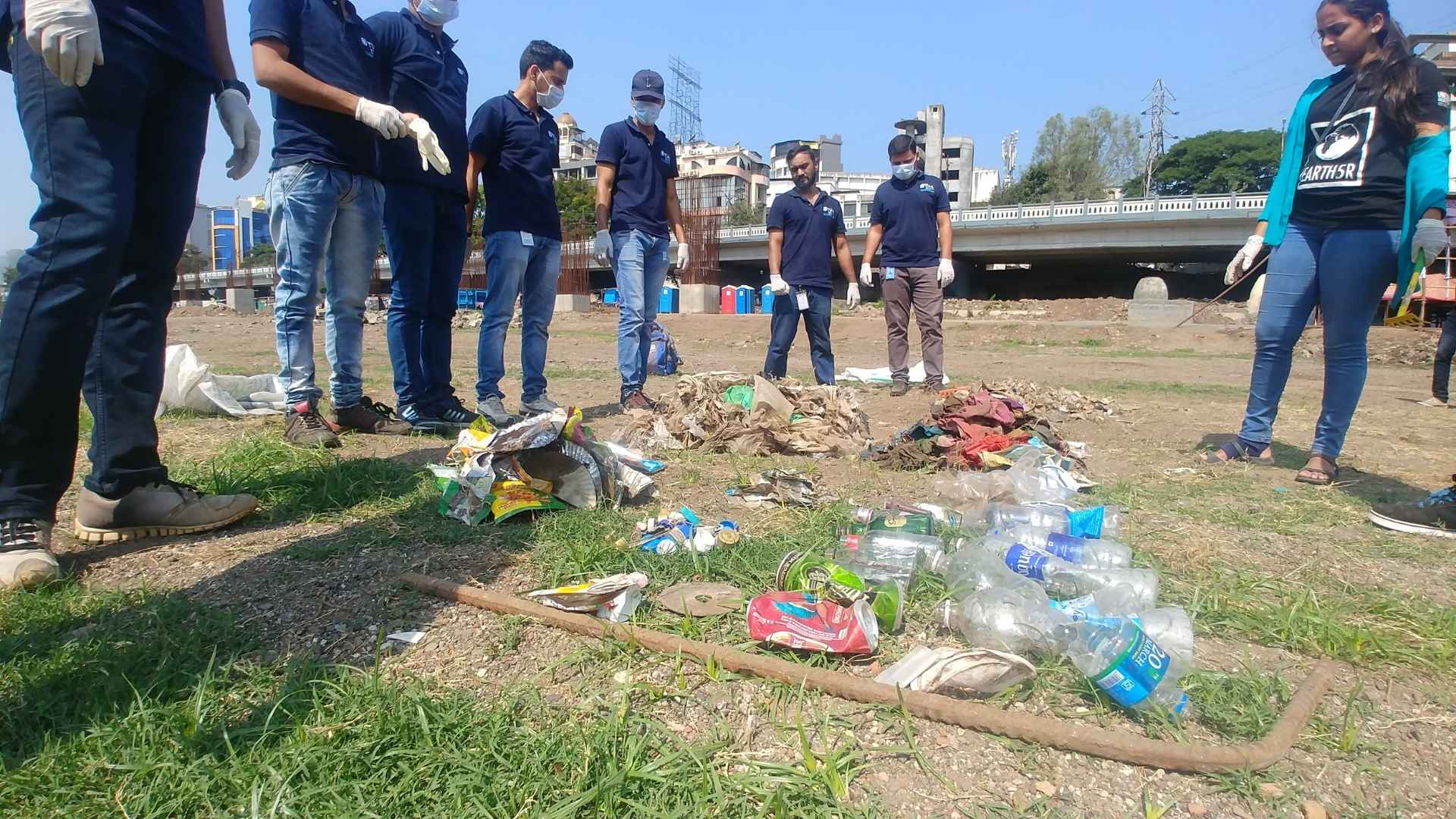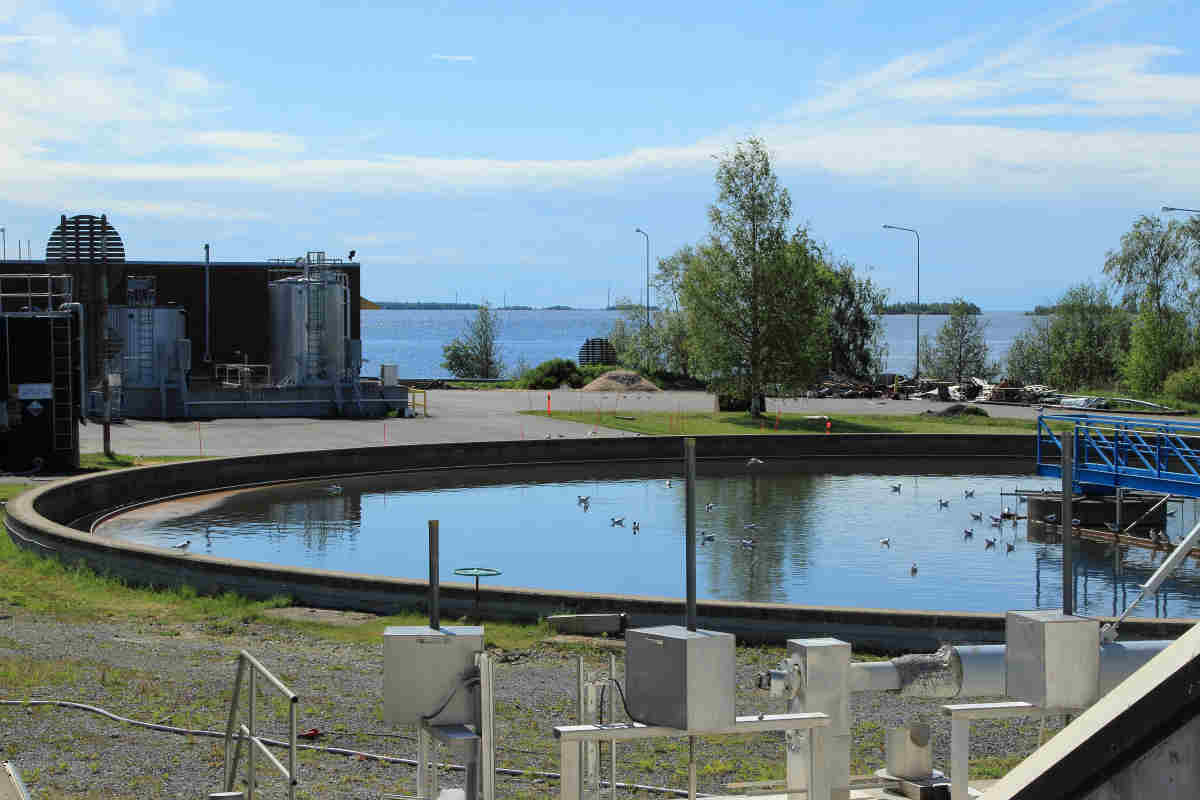The global waste crisis is accelerating at an alarming pace, with the world generating over 2.24 billion tonnes of solid waste annually, a figure projected to grow to 3.88 billion tonnes by 2050, according to the World Bank. Inadequate waste management, especially in developing countries, leads to severe environmental degradation, public health hazards, and the loss of valuable resources.
A significant contributor to this crisis is the failure to segregate waste at the source, which hampers recycling and composting efforts, and increases the burden on landfills and incinerators. Waste segregation—the process of separating organic, recyclable, hazardous, and non-recyclable waste—is a cornerstone of sustainable waste management.
When done effectively, it enhances material recovery, reduces greenhouse gas emissions, and promotes circular economy practices. However, implementing segregation at the community level often faces systemic and behavioral challenges. This is where Earth5R, a citizen-driven environmental organization, has introduced a high-impact, community-led waste segregation blueprint.
By combining grassroots mobilization, education, and tech-enabled solutions, Earth5R empowers communities to take ownership of their waste. This article explores the science, challenges, and transformative potential of Earth5R’s model, presenting research-backed insights and case studies that demonstrate how community participation can drive measurable environmental change.
The Science of Waste Segregation
Waste segregation is the process of separating waste into distinct categories to facilitate proper disposal, recycling, or treatment. The primary categories include biodegradable waste (organic matter such as food scraps and garden waste), recyclable waste (plastics, paper, glass, metals), hazardous waste (batteries, chemicals, medical waste), and electronic waste (e-waste), which includes discarded electronic appliances containing toxic components like lead, cadmium, and mercury.
Improper segregation leads to severe environmental and health consequences. When organic waste is mixed with recyclables or hazardous materials, it contaminates otherwise recoverable resources, reducing the effectiveness of recycling systems. Mixed waste often ends up in landfills or incinerators, generating methane and other greenhouse gases.
According to the United Nations Environment Programme (UNEP, 2021), open dumping and uncontrolled burning of mixed waste release toxic pollutants, including dioxins and furans, which are known carcinogens. In urban areas, this contamination poses direct health risks to sanitation workers and nearby residents.
Scientific research supports the critical role of source segregation—the practice of separating waste at the point of generation—in improving waste recovery and minimizing environmental damage. A study published in the journal Waste Management (Singh et al., 2019) found that segregation at source increased recycling rates by 65% in pilot cities across India.
Similarly, the World Health Organization (WHO) emphasizes that source-level segregation significantly reduces the health risks associated with handling mixed waste, particularly in informal settlements and low-income communities. Furthermore, proper segregation enhances the lifecycle value of materials. Clean recyclables command higher market prices and are easier to process.
For instance, unsoiled plastic and paper can be recycled up to 5–7 times, but contamination from organic waste renders them unrecyclable. In contrast, well-segregated organic waste can be composted or converted to biogas, contributing to local energy systems and soil health. Countries with robust segregation policies—such as Germany and South Korea—recover over 50% of their municipal waste for recycling and composting, largely due to stringent source-segregation practices.
Earth5R’s model builds upon these global best practices by integrating scientific principles with local community action, ensuring that waste segregation is not only environmentally effective but also socially inclusive. In sum, waste segregation is not just a technical necessity—it is a scientifically validated, cost-effective, and health-promoting strategy for sustainable urban living.
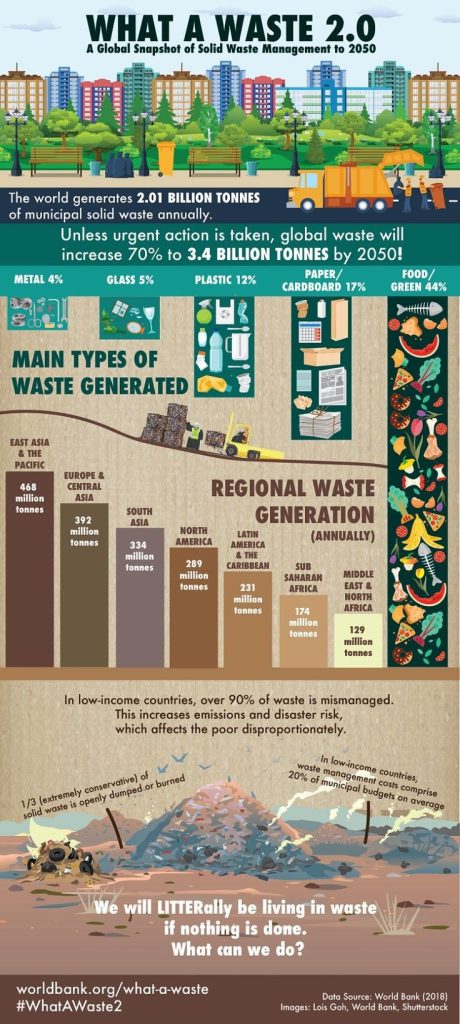
This infographic by the World Bank reveals that the world produces 2.01 billion tonnes of solid waste annually, projected to rise by 70% by 2050 without intervention. It highlights regional waste data and emphasizes the urgent need for improved waste management, especially in low-income countries.
Barriers to Effective Waste Segregation
Despite the clear environmental and health benefits of waste segregation, its implementation at scale faces multiple barriers—social, infrastructural, and institutional. These challenges often hinder the success of both government-led and private sector waste management initiatives, especially in developing countries.
One of the most significant hurdles is social and behavioral resistance. In many communities, there is limited awareness about the importance of waste segregation or how to do it properly. People often perceive waste as a nuisance to be discarded, not as a resource to be managed. Habits ingrained over decades—such as dumping all types of waste into a single bin—are difficult to change without sustained education and engagement.
A study in Waste Management & Research (Chakrabarti et al., 2020) found that even when segregation infrastructure is provided, lack of citizen motivation and understanding leads to low compliance rates. Another major barrier is infrastructure and logistics. Effective segregation requires a system of color-coded bins, timely collection, and specialized transportation.
In many cities, waste collection systems are not designed to handle segregated streams. Municipalities often lack adequate material recovery facilities (MRFs) or decentralized composting units. When segregated waste is mixed during collection or at transfer stations, citizens become disillusioned and are less likely to continue segregating at home. This breakdown in the waste value chain leads to contamination and resource loss.
Policy and governance issues further complicate the picture. While many local governments have laws mandating source segregation—such as India’s Solid Waste Management Rules, 2016—implementation and enforcement are weak. There is often a lack of coordination between different stakeholders, including municipal corporations, private contractors, and citizens.
Budgetary constraints and bureaucratic inefficiencies also impede long-term waste management planning. Case studies reveal the pitfalls of top-down segregation programs that fail to involve the community. For instance, in Bengaluru, a 2018 government initiative mandated segregation but did not provide adequate public outreach or consistent collection services.
As a result, compliance rates remained low, and most segregated waste was remixed and dumped. Similarly, in Cairo, Egypt, centralized waste reforms led to the displacement of the informal waste sector—‘zabbaleen’ communities—who were critical to source segregation, resulting in lower recycling rates overall (UN-Habitat, 2020).
In contrast, community-led approaches that build awareness, provide consistent infrastructure, and involve citizens in decision-making—like Earth5R’s model—have shown far greater success and sustainability. Understanding and addressing these barriers is key to designing effective waste segregation systems.
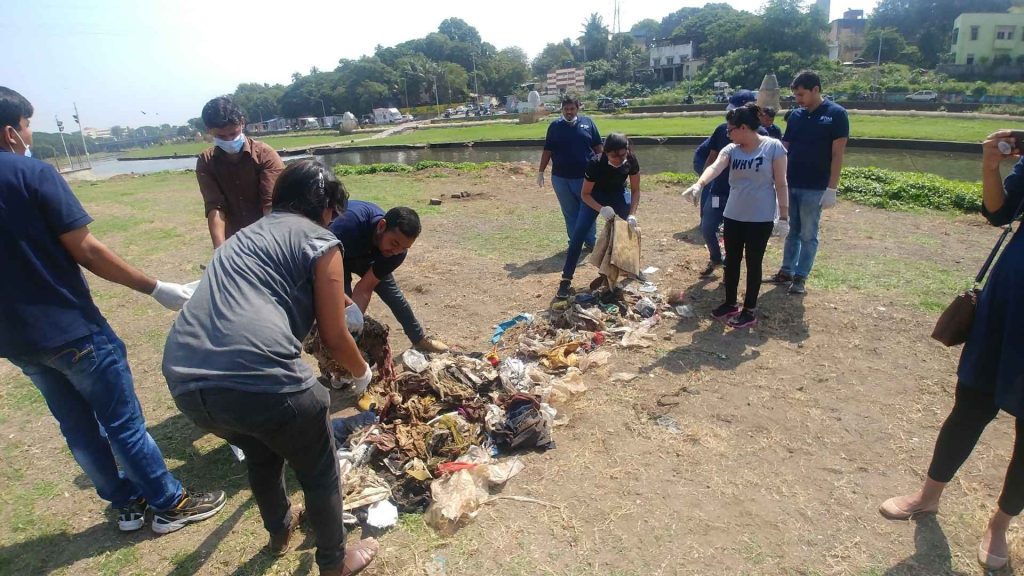
Earth5R’s Community-Led Segregation Blueprint
At the core of Earth5R’s waste management strategy is a simple yet powerful philosophy: citizen participation is the cornerstone of sustainable environmental change. Earth5R’s community-led waste segregation blueprint is a decentralized, inclusive model that mobilizes residents, local institutions, and informal workers to co-create and maintain sustainable waste ecosystems.
Rather than relying solely on municipal systems, Earth5R empowers communities to take ownership of waste at its very source—households, shops, schools, and offices. The blueprint begins with extensive community engagement. Earth5R’s trained environmental leaders—often local youth and women—conduct door-to-door awareness campaigns, helping residents understand the types of waste and how to segregate them effectively.
These campaigns are paired with clean-up drives, not only to improve sanitation but also to catalyze community bonding and accountability. Additionally, training sessions are held for schools, resident welfare associations, and commercial establishments, incorporating environmental education and practical demonstrations of segregation and composting.
To ensure transparency and impact tracking, Earth5R integrates tech-enabled tools into its model. Using mobile apps and digital dashboards, volunteers and residents log data on segregated waste volumes, collection frequency, and participation rates.
This creates real-time feedback loops that allow for targeted interventions and resource optimization. Earth5R’s data analytics also support broader research and policy dialogue on urban waste systems. A key strength of the blueprint lies in its multi-stakeholder partnerships. Earth5R collaborates with municipal corporations to align community action with local waste management systems.
This helps close the loop between source segregation and final processing at recycling or composting facilities. At the same time, corporate partnerships under Extended Producer Responsibility (EPR) frameworks enable Earth5R to support logistics, fund training programs, and recover post-consumer waste. These alliances ensure financial viability and scalability.
Another innovative aspect is the use of citizen science and community data gathering. Residents are trained to map waste hotspots, audit plastic use, and monitor air quality around waste dumping areas. This participatory approach not only democratizes data but also fosters environmental stewardship and advocacy.
Earth5R’s blueprint exemplifies how localized, inclusive, and data-driven strategies can transform waste segregation from a policy mandate into a grassroots movement. By bridging the gap between individuals, institutions, and systems, the model delivers scalable, high-impact environmental outcomes rooted in community resilience.
Case Studies & Impact Evidence
Earth5R’s community-led waste segregation blueprint has been successfully implemented across several Indian cities, generating measurable environmental and social impact. Through grassroots mobilization, strategic partnerships, and data-driven approaches, Earth5R has transformed waste management practices in urban and semi-urban neighborhoods. Below are three illustrative case studies that demonstrate the effectiveness of the model.
Powai, Mumbai, Maharashtra
In Powai, a densely populated suburb of Mumbai, Earth5R launched a pilot waste segregation project in collaboration with the Brihanmumbai Municipal Corporation (BMC) and local resident welfare associations. The initiative began with community surveys and door-to-door awareness campaigns, where over 1,200 households were trained in waste segregation techniques.
Within just six months of implementing the program in Powai, the impact was both rapid and substantial. Segregation at source surged from a mere 14% to an impressive 82%, reflecting a dramatic shift in community behavior. As a direct result of improved segregation, daily landfill-bound waste decreased by nearly 40%, easing pressure on Mumbai’s overburdened waste disposal systems.
Simultaneously, residents began composting over 200 kilograms of organic waste each week, transforming kitchen scraps into nutrient-rich compost used in community gardens and green spaces. Local resident Mrs. Radhika Mehta noted, “We never thought waste could become such a valuable resource. Now, we compost in our society garden and use the compost for our plants—it’s a complete cycle.” The success of the initiative prompted the BMC to replicate Earth5R’s model in two nearby neighborhoods, citing its high cost-effectiveness and community ownership.
Ukkadam, Coimbatore, Tamil Nadu
Ukkadam is a mixed-income area in Coimbatore where waste segregation had long been a challenge due to limited infrastructure and low awareness. In partnership with the Coimbatore Municipal Corporation and a local women’s self-help group, Earth5R launched a targeted program focusing on training women waste warriors, many from low-income backgrounds.
Over a span of eight months in Ukkadam, Earth5R’s targeted intervention led to a remarkable transformation in local waste management practices. Segregation rates increased from 22% to 79%, reflecting strong community adoption of sustainable habits. This behavioral shift resulted in the diversion of approximately 180 tons of waste from landfills, significantly reducing environmental impact.
According to Earth5R’s tech dashboard, recycling recovery improved by a factor of 3.2 compared to pre-intervention levels, showcasing the effectiveness of data-driven community engagement. Sangeetha, a local volunteer and waste warrior, summed up the collective pride of the neighborhood: “Earlier, we saw waste as dirty and dangerous. Now, we wear gloves, we sort, we teach others—and we feel proud. It’s our street, our environment.”
This model also created livelihoods for 25 women, who now earn through compost sales and recyclable material recovery.
Sion Dharavi Border, Mumbai
In one of the most waste-stressed urban areas of Mumbai, Earth5R initiated a community-driven project along the Sion-Dharavi border. The area was characterized by open dumping, irregular municipal collection, and significant health risks due to unsegregated waste. Earth5R collaborated with informal waste workers and NGOs to rehabilitate the system.
Over a 10-month intervention along the Sion-Dharavi border, Earth5R’s community-led approach yielded transformative results in one of Mumbai’s most waste-impacted areas. Landfill contributions decreased by 60%, while more than 15 tons of plastic waste were recovered and responsibly processed through recycling partners under Extended Producer Responsibility (EPR) guidelines.
The implementation of regular waste mapping and hotspot tracking led to a 70% reduction in illegal dumping zones, significantly improving local sanitation. Reflecting on this shift, Mohammed Irfan, a municipal sanitation supervisor, remarked, “We used to get complaints daily. Now, the complaints have turned into appreciation. Earth5R showed us that communities can lead the change.”
Previously plagued by garbage accumulation every 100 meters, the area now benefits from segregated collection zones, consistent volunteer-led cleanups, and tech-based monitoring, resulting in a visibly cleaner and more hygienic urban environment.
Conclusion of Impact
Across these locations, Earth5R’s community-led model has proven scalable and replicable. The combination of education, empowerment, and digital tracking led to significant reductions in landfill waste, higher recycling volumes, and improved community health and morale. These results offer compelling evidence that when communities are empowered with the right tools and knowledge, they can drive profound environmental transformation from the ground up.
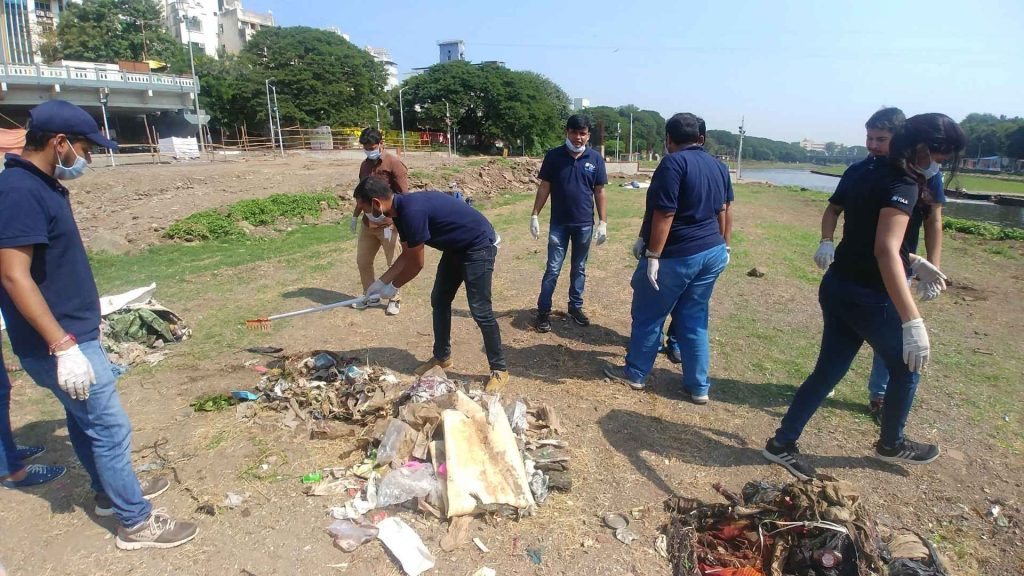
Comparative Analysis with Other Models
Earth5R’s community-led waste segregation approach stands out in contrast to conventional, top-down waste management systems that often rely heavily on government-run or centralized infrastructure. In traditional models, waste segregation is primarily enforced through legislation or by municipal authorities, and the emphasis is often on operational efficiency rather than community involvement.
This approach typically focuses on centralized waste collection, where residents may not be actively engaged in the sorting process, resulting in low compliance rates and inefficiencies in recycling. In contrast, Earth5R’s model emphasizes community ownership by involving residents at the very beginning of the waste chain—through education, engagement, and empowerment.
By training residents, especially women and youth, in segregation practices and providing localized infrastructure (color-coded bins, composting units), Earth5R fosters a sense of responsibility and ownership. This creates long-term, sustainable behavior change as citizens are directly responsible for waste management, making them more likely to adhere to segregation practices.
Internationally, Sweden and South Korea offer examples of highly successful waste management systems that combine government policy with community participation. In Sweden, waste segregation rates are among the highest globally, supported by comprehensive recycling infrastructure, stringent policies, and high public engagement.
However, it is important to note that the Swedish system is highly centralized, with most waste collection and sorting handled by municipalities. While successful, it may not be as easily replicable in developing nations with limited infrastructure. South Korea, on the other hand, has achieved remarkable success with a model that blends top-down enforcement with bottom-up community involvement.
The government imposes strict segregation laws, but local communities are actively involved in educating residents and managing waste sorting. Earth5R’s approach, like South Korea’s, integrates grassroots community participation but places even greater emphasis on empowering individuals to take ownership, rather than relying on government-enforced compliance.
In India, where government-led segregation programs are often inconsistent and poorly enforced, Earth5R’s model fills the gap by working directly with communities, providing continuous support, and leveraging technology to track progress—making it a more adaptive and sustainable solution.
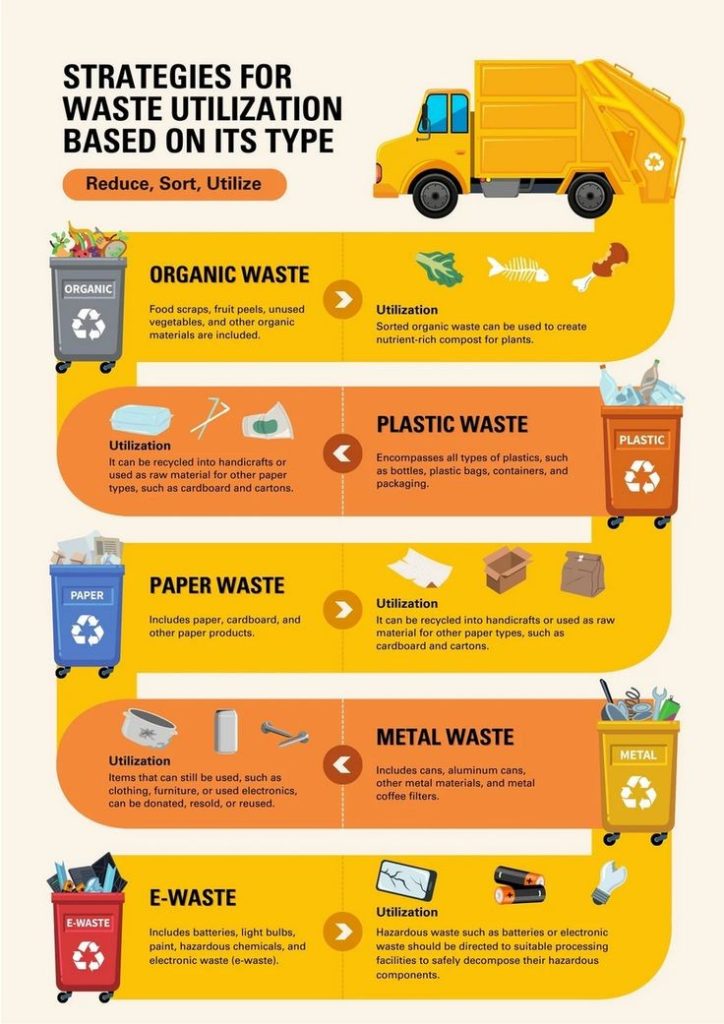
This infographic outlines effective strategies for waste utilization based on type—organic, plastic, paper, metal, and e-waste—focusing on reducing, sorting, and reusing. It emphasizes transforming waste into resources through composting, recycling, repurposing, and safe disposal methods.
Policy Implications & Recommendations
Earth5R’s community-led waste segregation model offers valuable lessons for national and state policies, particularly in the context of India’s ongoing waste management challenges. By integrating community participation, technology, and localized solutions, Earth5R’s approach can significantly inform future policy frameworks aimed at improving waste segregation, recycling, and sustainability at a national scale.
One key policy recommendation is the adoption of community-driven models as part of the national waste management strategy. Policies should promote local ownership by incentivizing communities to engage in waste segregation from the household level.
This can be supported by local governments providing infrastructure—such as color-coded bins, composting units, and waste management apps—and offering financial incentives for high-compliance communities. Additionally, policy frameworks should ensure that community-based initiatives are integrated with existing municipal waste collection systems, creating a seamless link between source segregation and end-processing.
To scale Earth5R’s model, national and state governments must create enabling environments through public-private partnerships (PPPs). Collaborations with corporations—especially those under Extended Producer Responsibility (EPR) frameworks—can fund community programs, improve waste collection infrastructure, and support recycling efforts.
Moreover, corporate involvement in awareness campaigns can help change public perceptions about waste, encouraging greater citizen participation. Another important policy focus should be on education and awareness. National campaigns that emphasize waste segregation, composting, and recycling can help build a culture of sustainability from the grassroots level.
Local governments should take an active role in incorporating waste management education into schools, communities, and workplaces, ensuring that residents are equipped with the knowledge and resources to segregate waste effectively. Finally, local governance must play a critical role in sustaining waste management systems.
Policies that delegate responsibility to local authorities, backed by training and resource allocation, will ensure that waste management becomes a community-centered effort, with visible outcomes and lasting impacts. Through such policies, Earth5R’s model can be scaled to create a national movement for sustainable waste segregation and environmental stewardship.
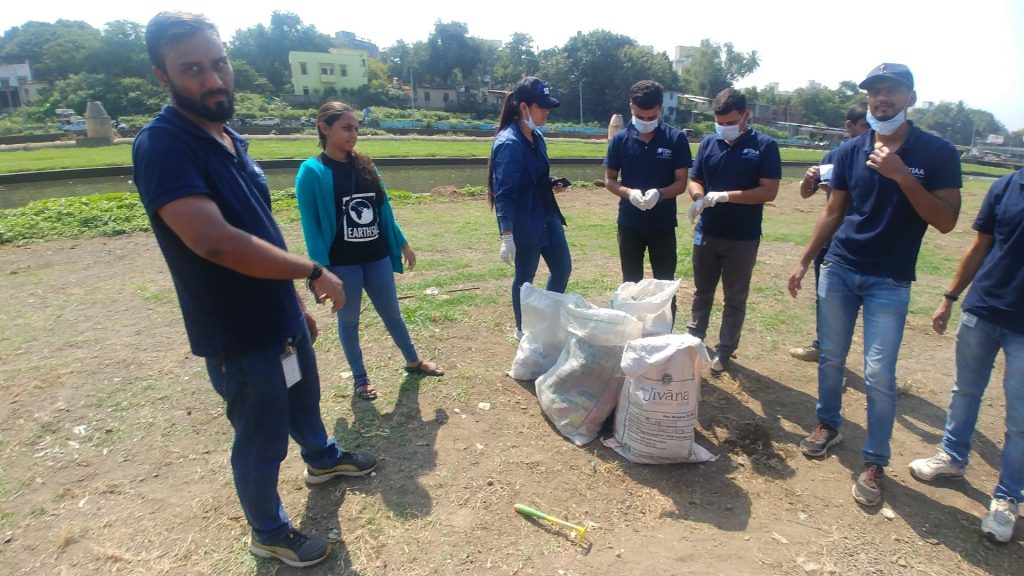
Empowering Communities for Sustainable Waste Management: The Impact of Earth5R’s Model
In conclusion, Earth5R’s community-led waste segregation model has demonstrated clear and measurable impact in multiple urban and semi-urban locations. The key findings from the case studies in Powai, Ukkadam, and the Sion-Dharavi border reveal the profound potential of community-driven waste management efforts.
Segregation rates increased significantly, landfill waste was substantially reduced, and recycling volumes saw impressive growth. The involvement of local communities, particularly through grassroots education and training, not only improved waste management practices but also fostered a deep sense of environmental stewardship among residents.
Earth5R’s approach, which integrates community ownership with technology-driven solutions, represents a stark contrast to conventional waste management systems. By involving residents in the segregation process, Earth5R has been able to achieve greater compliance, more efficient waste recovery, and a reduction in waste sent to landfills.
The model highlights the importance of bottom-up engagement, where local citizens are not passive recipients of waste management services but active participants in shaping a cleaner, more sustainable environment. The success of Earth5R’s model reinforces the crucial role of community leadership in achieving long-term waste management goals.
Unlike traditional top-down programs, which may struggle with enforcement and participation, Earth5R’s focus on educating and empowering communities creates a more resilient and sustainable system. This model shows that community leadership is not just a supplementary element but a core driver of successful waste segregation and environmental improvement.
As India and other countries face growing waste management challenges, Earth5R’s work offers valuable lessons for policymakers, local governments, and communities. It is clear that for waste management systems to be truly effective, they must be rooted in local engagement, education, and collaboration—principles that Earth5R has exemplified in transforming waste segregation from a policy mandate into a community-driven movement.
FAQs on Community-Led Waste Segregation: Earth5R’s High-Impact Blueprint
What is community-led waste segregation?
Community-led waste segregation refers to the practice of local residents taking active responsibility for separating their waste at source—typically into biodegradable, recyclable, hazardous, and e-waste categories—supported by awareness, infrastructure, and participation initiatives.
Why is waste segregation important?
Waste segregation helps reduce the amount of waste sent to landfills, improves recycling efficiency, prevents pollution, and supports circular economy initiatives.
How does improper waste segregation affect the environment and public health?
Improper segregation leads to landfill overflow, water and air pollution, greenhouse gas emissions, and health hazards from toxic or biomedical waste.
What makes Earth5R’s approach different from conventional systems?
Earth5R empowers local communities through education, training, and tech tools, emphasizing grassroots ownership over top-down enforcement models.
Which communities has Earth5R worked with?
Earth5R has implemented its model in urban and semi-urban areas like Powai, Ukkadam, and Sion-Dharavi, among others.
What types of waste are communities trained to segregate under Earth5R’s model?
Communities learn to separate biodegradable (wet), dry recyclable, hazardous, and electronic waste.
How does Earth5R use technology in its waste management programs?
Earth5R employs tech dashboards for tracking segregation rates, mapping hotspots, and monitoring recycling recovery through data analytics.
What role do volunteers play in Earth5R’s programs?
Volunteers conduct door-to-door awareness campaigns, run training sessions, assist in cleanups, and act as local waste ambassadors.
What measurable outcomes has Earth5R achieved?
Earth5R has facilitated segregation increases of up to 82%, landfill waste reductions of 40–60%, and plastic recovery volumes in the tens of tons.
How does community engagement improve waste management outcomes?
When residents feel ownership over the cleanliness of their environment, they are more likely to maintain sustainable habits and influence their peers.
Can this model work in low-income or informal settlements?
Yes, Earth5R has successfully implemented its model in densely populated, underserved areas by customizing engagement strategies and working with local stakeholders.
Are there economic benefits to community-led segregation?
Yes, communities can monetize recyclables, reduce municipal costs, and create green jobs (e.g., composting, collection, sorting).
How does Earth5R’s model compare to systems in Sweden or South Korea?
While Sweden and South Korea have advanced, government-led systems, Earth5R stands out by centering communities and adapting its approach to infrastructural gaps in India.
Why do many top-down segregation programs fail?
Lack of public awareness, insufficient infrastructure, and poor enforcement often cause traditional segregation policies to underperform.
Can Earth5R’s model be scaled nationally?
Yes, with the right support from local governance, public-private partnerships, and national policy integration, Earth5R’s model is scalable across urban and rural India.
What role should the government play in supporting community-led segregation?
Governments should provide infrastructure, funding, training, and policy support to enable community groups to lead segregation efforts effectively.
How can schools and institutions contribute to community segregation models?
By integrating environmental education into curricula and hosting waste management initiatives, schools can act as hubs of community awareness.
How can I start a community segregation initiative like Earth5R’s in my area?
Begin by educating your neighborhood, organizing clean-up drives, connecting with NGOs like Earth5R, and reaching out to your local municipality for support.
What are some simple steps households can take to improve segregation?
Use three separate bins for wet, dry, and hazardous waste; clean and dry recyclables; compost organic waste at home; and dispose of e-waste responsibly.
Can corporates support Earth5R’s initiatives?
Yes, many corporates contribute via CSR programs and EPR partnerships, funding waste education, infrastructure, and recycling logistics.
Be the Change, One Bin at a Time
The waste crisis is not just a government problem—it’s a community challenge that each of us has the power to solve. Earth5R has shown that when people come together, equipped with knowledge and purpose, they can turn trash into transformation.
Now, it’s your turn. Start by segregating your waste at home—separate your wet, dry, hazardous, and electronic waste. Educate your neighbors. Organize a local clean-up. Connect with citizen groups. Demand better infrastructure from your local authorities. And most importantly, lead by example. Whether you’re a student, a resident, a policymaker, or a corporate leader, you have a role to play in building cleaner, healthier, and more resilient communities.
Join the movement. Start segregating. Empower your community. Let’s build a zero-waste future—together.
~Authored by Ameya Satam

